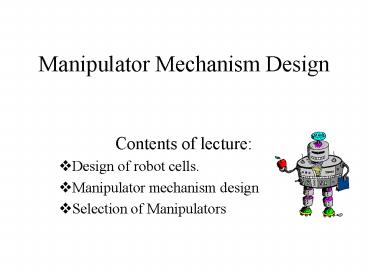Manipulator Mechanism Design PowerPoint PPT Presentation
1 / 20
Title: Manipulator Mechanism Design
1
Manipulator Mechanism Design
- Contents of lecture
- Design of robot cells.
- Manipulator mechanism design
- Selection of Manipulators
2
A Robot Cell
- Robot arm
- (manipulator)
Tool
Fence
Fixture
3
A Robot System
Additional equipment
Fixtures
4
Selecting a Manipulator
Typical price 25 of total robot system
5
Task Dependent requirements
- Workspace
- Must reach a number of fixtures and workpieces
- Air around fixtures and workpieces in order to
avoid collisions - Consider the shape and singularities
- Load capacity
- Speed
- Repeatability and accuracy
6
Degrees of Freedom (DOF)
- General positioning and orienting requires 6
degrees of freedom (DOF). - Tasks with with symmetric tool requires only 5
DOF (welding, grinding, polishing etc.)
- Positioning parts on planar surface (pick and
place) requires only 4 DOF (X,Y,Z and ?).
7
Degrees of Freedom (DOF)
- Application of external tilt/roll manipulators
may be required due to process requirements
(welding)
- Externally applied DOFs counts in the system.
I.e. symmetric tool and 2 External DOFs leaves
only a requirement for 3 DOFs in the robot. - Symmetric parts may reduce the number of required
DOFs.
8
Kinematic configuration
- Number of joints equals number of DOFs for serial
kinematic linkages. - Positioning structure and orienting
structure/wrist. - Classification according to first 3 joints
(positioning structure)
9
Kinematic configuration
Articulated (RRR)
- Two shoulder joints (vertical horizontal
elevation) and an elbow joint parallel to the
elevation joint. - Provides the least intrusion of the manipulator
structure into the workspace.
10
(No Transcript)
11
Kinematic configuration
Cartesian (TTT)
- Stiff structures allow construction of large
robots, often referred to as gantry robots. - Does not produce kinematic singularities for
first 3 axes. - All feeders, fixtures and other equipment must be
placed inside the robot
12
(No Transcript)
13
Kinematic configuration
Scara (RRT)
- Three revolute parallel joints allowing it to
move and orient in plane. - First three joints dont support weight of
manipulator/tool/workpiece. - Usually very fast robots.
- Well suited to pick and place.
14
Kinematic configuration
Spherical (RRT)
- Much like articulated robot, except that joint 3
is prismatic. - More suitable than articulated robot for some
applications (entering narrow holes).
15
Kinematic configuration
Cylindrical
- Much like spherical robots, except that joint 2
is prismatic. - More suitable to some applications than
articulated and spherical robots.
16
Kinematic configuration
Closed structures
- Increased stiffness
- Reduced allowable range of motion
17
(No Transcript)
18
Exercise
19
Skitse af bukkecelle I
20
Skitse af bukkecelle II

